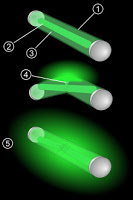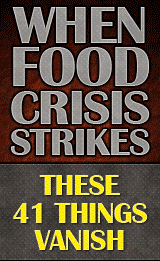 |
| (source Wikipedia) |
Gaye Levy, Contributing Writer
Activist Post
Chemical lighting is always recommended as a mainstay for survival kits, but the reasons, at least to me, have never been 100% clear. Yes, I knew they were inexpensive, but also they were for one-time use. Wasn’t my trusty tactical LED or Maglite a better solution? Yes and no.
Today I would like to explore the ins and outs of chemical lighting. Or, more specifically, light sticks.
A light stick – also called a glow stick – is a mix of chemicals housed in a plastic sheath or tube.
Basically, the way it works is that you bend the sheath then shake it up to mix the contents, creating a chemical reaction that emits energy with only a teeny emission of heat (chemoluminescence).
The diagram above provides some detail.
1. Plastic casing covers the inner fluid.
2. A glass capsule covers the solution.
3. Phenyl Oxalate and fluorescent dye solution.
4. Hydrogen Peroxide solution.
5. After the glass capsule is broken and the solutions mix, the glow stick glows.
The result is a brightly colored, diffused light that is good for short-term illumination, typically 6 to 12 hours depending on the length, chemical composition in the sheath and ambient temperature.
So why should you have some light sticks in your home, your vehicle and your survival backpack?
Well for one, they are safe in all environments, including those where questionable or even undetectable gases may exist. They are weatherproof, windproof, non-flammable, non-sparking, have a great shelf life and are very inexpensive. Plus, most light sticks can be seen from a mile away – great in rescue situations.
They come in various lengths and durations, with 6 or 10 inches being quite popular, with a duration of 30 minutes up to 12 hours. Whereas duration is determined by the chemistry of the formulation, brightness is affected by temperature: the warmer the temperature, the brighter the light will appear.
There are also small and compact mini 4” light sticks which are great for handbags, medical kits, and glove boxes in vehicles. They can provide up to 4 hours of illumination in a compact package.
The shelf life is at least four years especially when packaged in foil packaging. Plus one popular brand, the Cyalume Snaplight, is manufactured in the United States.
What’s not to like? There are just a few bug-a-boos.
Depending on your needs in the moment, the standard 360-degree illumination may be an annoyance. Also, the longer rated 8 to 12 hours light sticks will definitely start to dim after a few hours and dim considerably towards the end of their rated life. The same thing will happen at each end of the heat spectrum, with overall brightness starting to dim in cooler temperatures below 40 degrees and temperatures over 80 degrees. Also, once activated by breaking the internal glass vial and combining the chemicals, they cannot be turned off.
Alternatives to chemical lighting are candles and flashlights. While both have their place in the survival kit, there are some downsides.
Candles:
- Candles can be dangerous if extreme care is not taken in their use. For example, candles caused 23,600 fires, 200 deaths, 1,600 injuries in the U.S. last year. Furthermore, the Red Cross warns against any emergency use of candles in the home due to severe risk of fire.
- Candles are not wind and waterproof and cannot be used outdoors.
- Candles should not be left unattended and cannot and should not be used as all-night lights or by children or the elderly.
- Candles consume oxygen and should not be used in confined spaces.
- Candles go out when dropped and are not a mobile light source.
- Candles are risky to use when natural gas or other fuels are present
Flashlights:
- Batteries lose power and may leak or corrode when stored for an extended time.
- Flashlights are great searchlights but give poor room illumination.
- Light bulbs and lenses are breakable. When broken, they are useless.
- Only very high-cost flashlights are truly waterproof.
- Flashlight internal circuits are subject to corrosion.
Military Grade? Industrial Grade? What is the difference?
There is no discernable difference in either light output or duration between these two grades. It seems that the only difference between the two is that the U.S. military, for reasons best known to it, requires a slightly different formulation for their light sticks. This formulation has a four-year shelf life, while the Industrial Grade formulation has a five-year shelf life.
Go figure. The bottom line is this: the Military Grade version is a good light stick, but not worth the 25% extra you pay over the Industrial Grade light stick which produces the same amount of light and lasts just as long.
The Final Word
Light sticks, or glow sticks, are a safe and inexpensive addition to your home, your vehicle and your gear kit. The have a myriad of uses. A pack of 10 will cost between $10 and $15, and even less on a per unit basis if you purchase a larger supply of 50 or more. They will last for 4 years at a minimum; and, if stored properly, even longer.
Chemical light sticks are readily available at Lowes, Amazon and many outdoor stores. The only caveat is to avoid those sold as a consumer item (read “toy” and party) since they are not the same quality as an Industrial Grade or Military Grade light stick.
Here are some selections to get you started:
Cyalume SnapLight Industrial Grade Chemical Light Sticks, 6″, 12 Hour Duration
Cyalume SnapLight Industrial Grade Chemical Light Sticks, 6″, 8 Hour Duration
Cyalume Mini ChemLight Military Grade Chemical Light Sticks, Green, 1.5″, 4 Hour Duration
Gaye Levy, the SurvivalWoman, grew up and attended school in the Greater Seattle area. After spending many years as an executive in the software industry, she started a specialized accounting practice offering contract CFO work to emerging high tech and service industries. She has now abandoned city life and moved to a serenely beautiful rural area on an island in NW Washington State. She lives and teaches the principles of a sustainable, self-reliant and stylish lifestyle through emergency preparation and disaster planning through her website at BackdoorSurvival.com. SurvivalWoman speaks her mind and delivers her message with optimism and grace, regardless of mayhem swirling around us. Enjoy your next adventure through common sense and thoughtful preparation!
linkwithin_text=’Related Articles:’



Be the first to comment on "Lighting Your Way With Chemical Lighting"